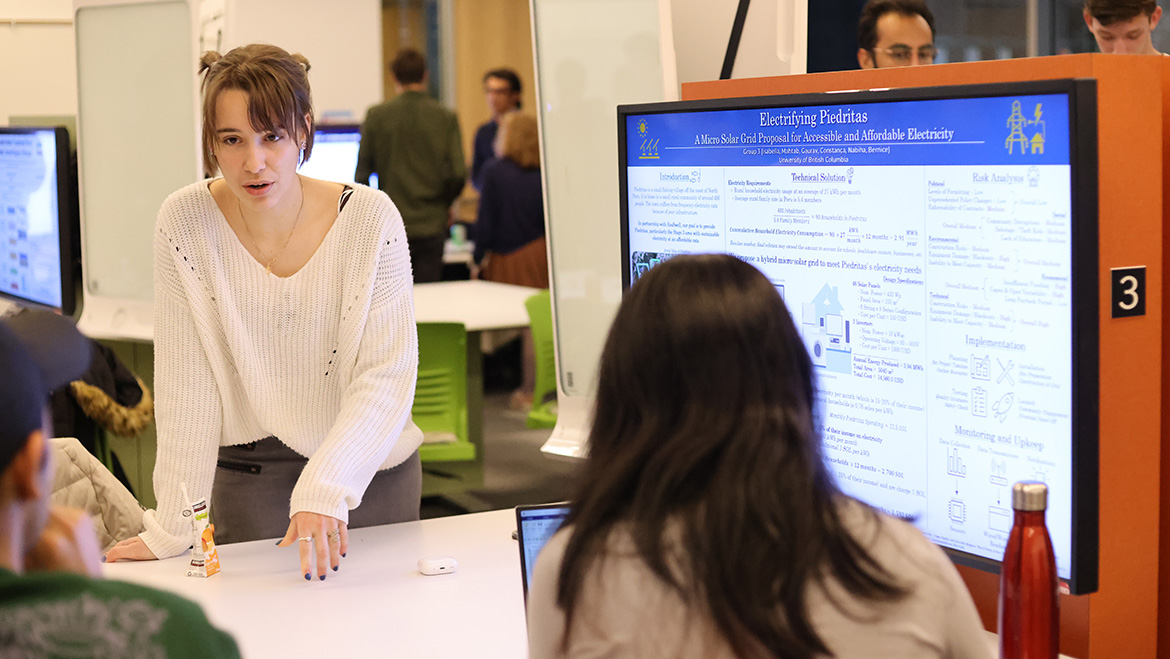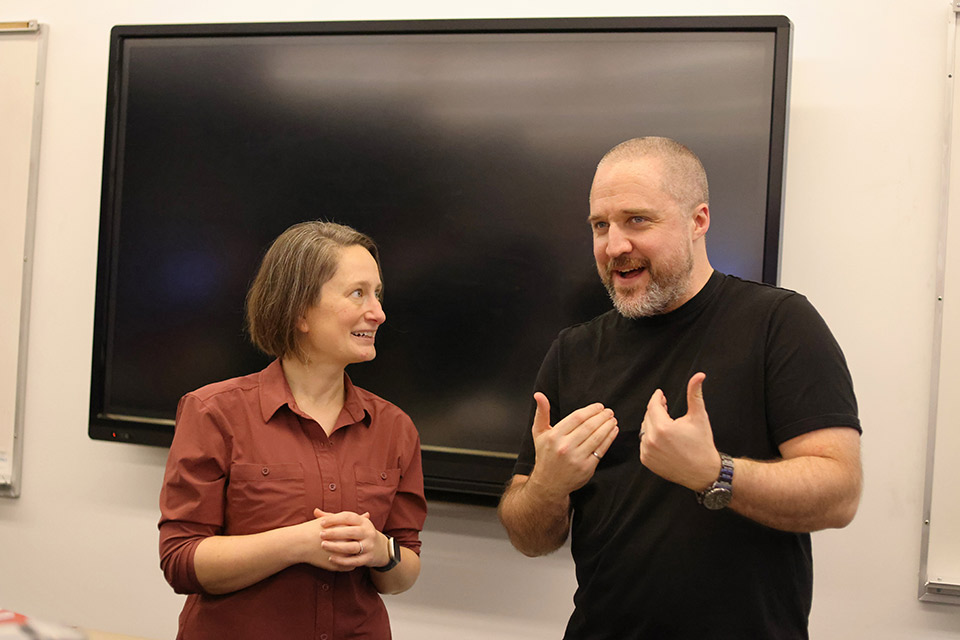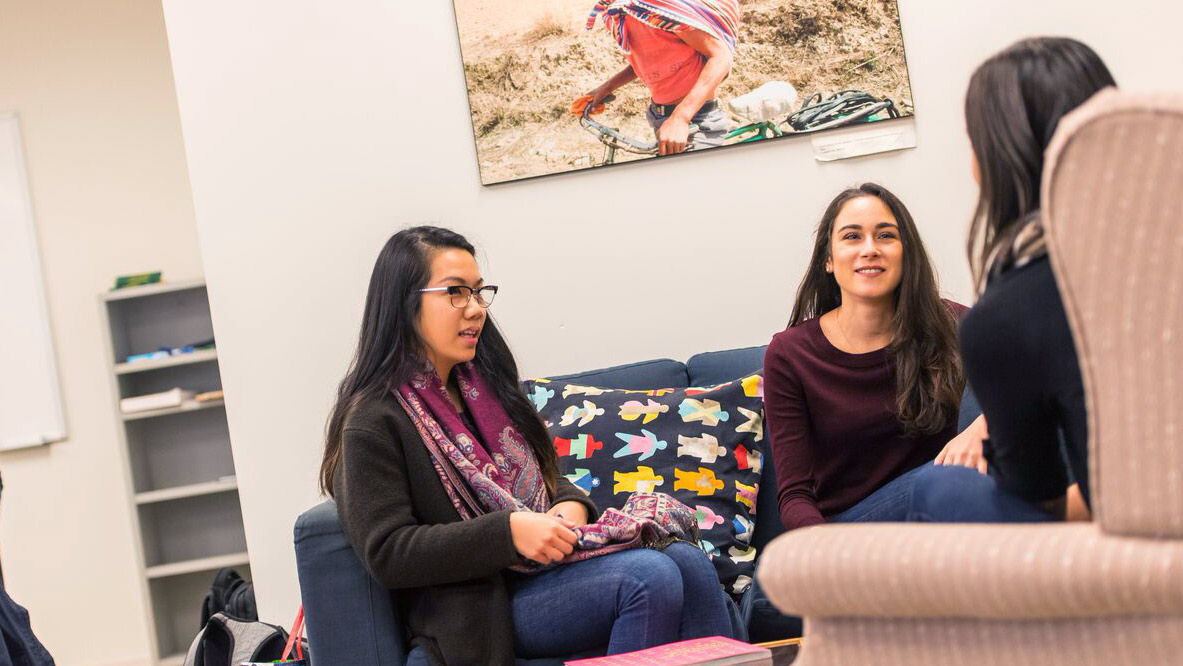

International relations student Constança Sousa discusses her team's project at the December showcase for UBC's new Humanitarian Engineering course. Photo: Rebecca Lyon/UBC Applied Science
In a pioneering move, the University of British Columbia has developed a unique course that pairs arts and engineering students together to develop solutions to humanitarian crises within B.C. and around the world. The popular and new course called ‘humanitarian engineering’ was led by Political Science professor Dr. Jenny Peterson and Chemical Engineering professor Dr. Gabriel Potvin.
Both faculty members agree that this cross-Faculty approach to teaching and learning is a leap in the right direction toward multidisciplinary ways of knowing. “For many reasons, some good and some bad, in academia disciplines tend to be siloed, and there are very few opportunities to venture outside of disciplinary boundaries. This course is one of the rare opportunities to do so,” says Dr. Potvin. “There is a degree of demystifying what other students are doing on campus—the ways they work and the way they think. In this sense, it allows arts students to fully appreciate what engineering students are doing, and vice versa. I think that both sets of students have acquired different skills and perspectives from working with each other,” Dr. Peterson emphasizes.
Audrea Wang, a fourth-year political science student and human rights advocate, expressed how her cross-Faculty experience reframed her perspective on the misuse of new technological developments. After completing her design course alongside engineering students and the Sehgal Foundation, an NGO based in Vaishali District in India, Wang says: “Interdisciplinary cooperation throughout this course has shown me the potential for technology to promote positive change. For example, by taking a human rights by design approach, our team was able to come up with built-in measures to mitigate possible harms relating to waste management and health.”
We spoke more with Dr. Peterson and Dr. Potvin about their decision to take a fully interdisciplinary approach to teaching, why it enhanced the learning environment, and as a result, how their students were able to work on real humanitarian projects with NGOs.
Can you elaborate on the decision to take a fully interdisciplinary approach and why it is considered crucial for addressing humanitarian challenges?
Dr. Peterson: Working in interdisciplinary spaces can unleash creativity. Being exposed to new ideas and new people can be a catalyst for innovation and solutions. Working in interdisciplinary spaces teaches you about the strengths and limitations of your own discipline in really important ways. For me, working with people from other disciplines has really helped clarify what I have to offer as a political scientist.
In what ways do you believe this approach enhances the learning experience for both engineering and arts students?
Dr. Potvin: Students have the chance to work on real challenges, making the learning experience richer, more genuine, and more directly applicable to “real-world” projects. This approach helps engineering students become better engineers by giving them a greater appreciation of the social aspects inherent to their design work, and allowing them to develop tools and strategies for context and political analysis, and social sustainability assessment. Likewise on the arts side, this approach asks political science and international relations students to explicitly consider the practical deployment and implementation of their work, and to understand some of the physical and technical constraints associated with their projects, as well as to identify technical tools and approach that best align with the social analyses that are more commonly their purview. The end result is that everyone gains real practical experience with applying their disciplinary expertise to important multidisciplinary challenges, in a more authentic environment than in a traditional course.
“Having professors from both departments was very enjoyable. As students, we are inclined to take our professors’ words without question, despite there often being numerous ways of understanding the same problem. Observing discussions between Dr. Peterson and Dr. Potvin allowed us to engage more critically with the material and our assignments. Given the interdisciplinary nature of the course, having specialists in both fields available at office hours meant that we were exposed to a large range of information and resources not typically accessible in a singular arts or engineering class.”
What makes this program unique in terms of approach and outcomes?
Dr. Peterson: We think that the design projects and having all students (regardless of discipline) work on all elements of the project, both technical and socio-political, is what sets this course apart. Their engagement with NGO partners was a key part of this as well. These weren’t fictional projects, but real life situations where NGOs could benefit from both technical advice, but also advice on how to engage with communities in ways that were sensitive to culture, power dynamics, economic systems, etc.
How were the partnerships with the NGOs established, and how do they contribute to the overall learning experience for students?
Dr. Potvin: We approached NGOs working on humanitarian projects that would require some technological or designed technical intervention. Each NGO provided us with information on a real humanitarian project they were working on, which was then assigned to a mixed discipline team of students (i.e. 2-3 engineering and 2-3 political science/international relations) at the beginning of the course. Each team periodically consulted with a representative of their partnering organization throughout the terms as they worked on different aspects of the project, exchanging ideas and receiving feedback. Students gained experience working with complex problems and in interdisciplinary teamwork, all with the potential to have a real impact on the people for whom the projects were designed, through their NGO partners.
“I hope that the course has led Arts students to understand the role that they can play in more technical industries and projects, and their ability to add great value. I hope it has expanded their imagination in terms of job opportunities and industries where their skills are relevant.”


Dr. Jenny Peterson and Dr. Gabriel Potvin co-taught every lecture. Photo by UBC Applied Science.
Have there been any surprises or observations regarding the dynamics of mixed interdisciplinary teams during the course?
Dr. Peterson: I was surprised how quickly it became impossible to tell who was an engineer and who was a political science/international relations student. Other than the first day where we intentionally had them sit on different sides of the room– during class discussions there was very rarely any way of telling which student came from which discipline.
Dr. Potvin: We had engineers confidently discussing the political context of the locales in which their projects would be deployed, and arts students enthusiastically explaining why their team chose to use electromagnetic flow meters instead of mechanical ones in their designs. Each team member, though certainly spearheading the sections of the project most aligned with their disciplinary expertise, were happy to share their knowledge with their teammates, and to learn from them at the same time, with the end result being high-quality project reports, each section of which the result of interdisciplinary collaboration, and stronger for it.
What was it like to teach each class with an instructor from a different faculty? What did you find most valuable – and what was challenging?
Dr. Peterson: When teaching on your own you don’t have to spend as much time thinking about or justifying each decision you make. Because every element of the course was worked on and agreed upon by both of us, we had to spend a lot of time explaining our rationale behind things to the other instructor, which was time consuming sometimes. This brought to the surface disciplinary differences but also, on a more basic level, uncovered just different preferences we had around teaching and class management. It could be frustrating at times, but ultimately I think this made us better instructors and also meant that we were dealing with some of the same issues our students were dealing with in interdisciplinary teams. It meant we also understood their struggles but could also model to the students how to work through those differences.
“Beyond the interdisciplinary element—teaching with someone from a different faculty and discipline introduced me to new teaching ideas and practices. Sometimes our productive disagreements around course design and assessments made me think more carefully about my own practices and assumptions about what good teaching looks like. It has made me a more flexible and hopefully innovative instructor in all of my other courses.”


